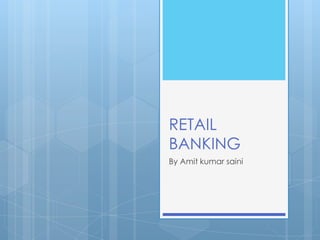
Retail banking ppt
- 1. RETAIL BANKING By Amit kumar saini
- 2. INTRODUCTION “Retail banking is typical mass-market banking where individual customers use local branches of larger commercial banks. Services offered include: savings and checking accounts, mortgages, personal loans, debit cards, credit cards, and so
- 3. HISTORY Organized banking services started in 15th and 16 century Europe, when banks began opening branches in commercial areas of large cities By the last quarter of 19th century banks were consolidating their branch networks so that they could operate in a more integrated manner.
- 5. Today’s retail banking sector is characterized Multiple products Multiple channels of distribution Multiple customer groups
- 6. The future of retail banking: A global perspective Indian retail banking has been showing phenomenal growth In 2004-05, 42% of credit growth came from retail Over the last 5 years CAGR has been over 35%
- 7. Rural areas offer tremendous potential too which needs to be exploited
- 8. Advantages Your money is much more secure than in a box under your bed and you can buy goods, be paid, and sell things without cash changing hands Thebank you are familiar with and which knows you can also offer you a wide range of other services, such as mortgages and insurance.
- 9. Retailbanks offer a variety of ways you can access your account and manage your money RetailBanking focuses on individual and small units
- 10. The risk is spread and the recovery is good Surplus deployable funds can be put into use by the banks Customize and wide ranging products are available
- 11. Disadvantages Banksare a business, and they need to make money from looking after yours. If the bank decides to apply charges to your account (within the terms of the account), you may only find out about it afterwards—for example if you accidentally go overdrawn without permission. If you disagree with a charge, you will need to contest it to recover the money.
- 12. Retail Banking services Theobjective of the Retail Bank is to provide its target market customers a full range of financial products and banking services, giving the customer a one-stop window for all his/her banking requirements
- 13. Accounts & Deposits ATM Savings Accounts Current Accounts Trading accounts Fixed Deposits Internet Banking Mobile Banking
- 14. Loans Home Loans Personal Loans Car Loans Commercial Vehicle Loans Loans against Securities Education loan
